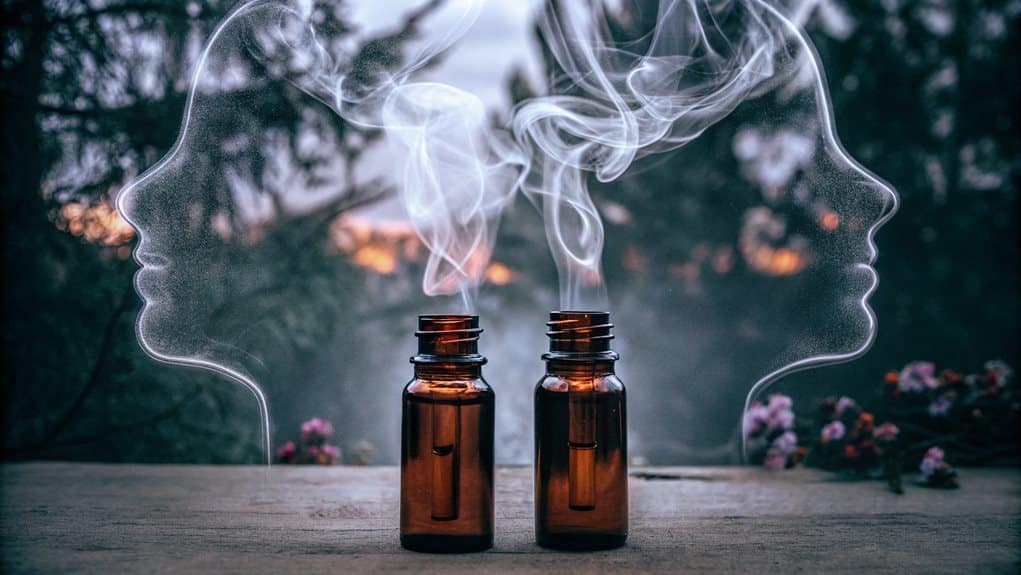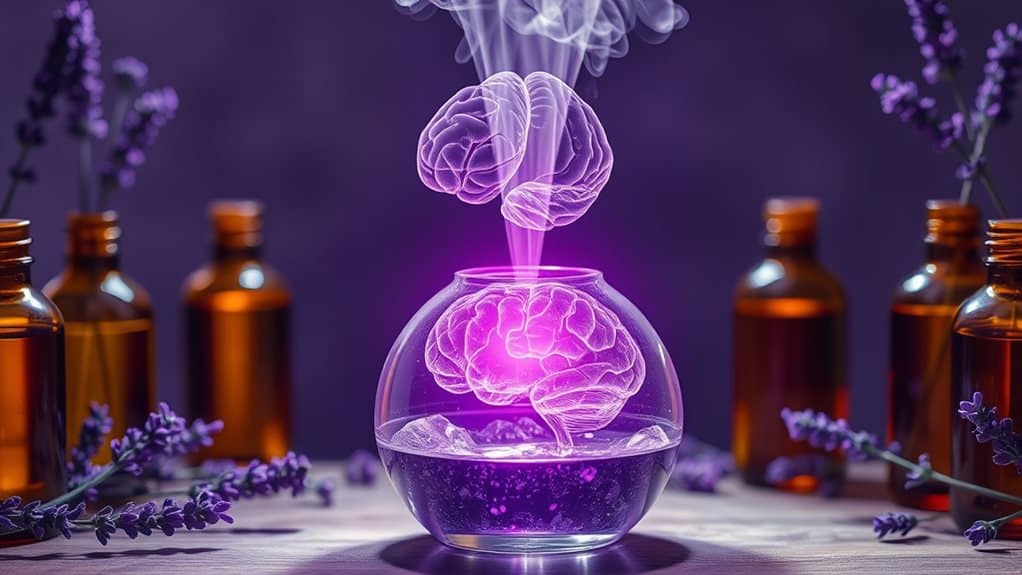Table of Contents - click here
ToggleHave you ever caught a whiff of freshly baked cookies and suddenly found yourself transported back to your grandmother’s kitchen? Or perhaps the scent of a particular perfume unexpectedly brought back memories of a loved one? These experiences aren’t just coincidental—they’re rooted in the fascinating neurological connection between our sense of smell and our memory systems.
In this article, we’ll explore the science behind how scents influence memory and cognition, and examine the evidence for how certain essential oils might support brain function. While aromatherapy isn’t a miracle cure for cognitive issues, understanding this connection can help you make informed choices about incorporating beneficial scents into your daily routines.
The Science Behind Scent and Memory
How Your Brain Processes Scents
The relationship between scent and memory is unique compared to our other senses. When you smell something, the scent information travels along a direct pathway to areas of your brain involved in emotion and memory processing—specifically, the limbic system, which includes the amygdala and hippocampus.
Dr. Rachel Herz, a cognitive neuroscientist at Brown University who specializes in the psychology of smell, explains: “Smell and memory are so closely linked because the anatomy of the brain allows olfactory signals to reach the limbic system with fewer synaptic connections than other sensory systems. This creates stronger, more immediate emotional associations with scent memories.”
This neurological shortcut explains why scents can trigger memories and emotions so powerfully and with such immediacy. Unlike visual or auditory information, which must first be processed through the thalamus, scent information has a more direct route to emotional and memory centers.
Key Aspects of the Scent-Memory Connection
Research has established several important characteristics of how scent affects memory:
Emotional Intensity: Studies published in the journal Chemical Senses have shown that memories evoked by scents tend to be more emotional than memories triggered by other sensory cues.
Persistence: Scent-associated memories can remain intact even when other types of memories fade. Research in the Journal of Neuroscience suggests that the neural pathways connecting scent and memory are particularly resistant to age-related deterioration.
Unconscious Processing: We often process scents before we’re consciously aware of them. This unconscious processing can influence mood and cognition without our explicit awareness.
Contextual Learning: The brain forms stronger memories when learning occurs in the presence of distinctive scents, a phenomenon researchers at the University of California have documented in several studies.

Essential Oils and Cognitive Function: What the Research Shows
While traditional aromatherapy has used essential oils for centuries, scientific research is still catching up to understand exactly how these plant extracts might influence brain function. Here’s what current evidence suggests about several commonly used essential oils.
Rosemary: Potential Memory Support
Rosemary essential oil contains compounds like 1,8-cineole that may influence cognitive performance. A 2012 study published in Therapeutic Advances in Psychopharmacology found that exposure to rosemary aroma was associated with improved performance on memory tasks.
However, it’s important to note that these improvements were modest—participants showed approximately 5-7% better recall compared to controls. This is significant but far from the dramatic improvements sometimes claimed in marketing materials.
How to use: Consider diffusing rosemary oil while studying or working on mentally demanding tasks. A simple technique is to place 2-3 drops in a diffuser in your workspace for 30-minute intervals.
Peppermint: Focus and Alertness
Research published in the International Journal of Neuroscience suggests that peppermint scent may enhance alertness and attention. The refreshing aroma appears to stimulate the central nervous system, potentially helping maintain focus during mentally taxing activities.
A 2018 review in Nutrients found that peppermint’s primary component, menthol, may temporarily increase blood flow to the brain, which could contribute to its alertness-promoting effects.
How to use: For a quick focus boost, try placing a drop of peppermint oil on a tissue and taking several deep breaths when you feel your attention wandering. Always keep the tissue at a safe distance from your face to avoid direct contact with the oil.
Lavender: Stress Reduction and Cognitive Support
Lavender is perhaps the most well-researched essential oil for stress reduction. Multiple clinical studies have demonstrated its anxiety-reducing properties, which indirectly may support cognitive function since stress is known to impair memory and attention.
A 2014 study in the Journal of Alternative and Complementary Medicine found that participants who inhaled lavender oil before stress-inducing tasks maintained better working memory function compared to a control group.
How to use: Diffuse 2-3 drops of lavender oil in your environment during times of stress or before bed to potentially support relaxation. For many people, reduced stress can translate to improved cognitive performance.
Practical Applications for Daily Life
Supporting Sleep Quality
Quality sleep is fundamental to cognitive function and memory consolidation. Research indicates that certain scents may help create conditions conducive to better sleep, which in turn supports overall brain health.
A systematic review published in Sleep Medicine Reviews found moderate evidence that lavender aromatherapy may improve sleep quality in people with mild sleep disturbances. Other scents that have shown preliminary evidence for sleep support include chamomile and cedarwood.
Suggested evening blend: In a diffuser, combine:
- 3 drops of lavender oil
- 2 drops of chamomile oil
- 1 drop of cedarwood oil
Begin diffusing this blend 30 minutes before bedtime as part of a consistent sleep routine.
Managing Stress-Related Headaches
Tension headaches often accompany mental fatigue and stress, creating a cycle that impairs cognitive function. Certain essential oils have demonstrated potential for headache relief in clinical studies.
A 2012 placebo-controlled study published in European Neurology found that applying a 10% peppermint oil solution to the forehead and temples reduced headache intensity significantly more than placebo. Similarly, lavender inhalation has shown promise for migraine relief in some clinical trials.
Tension headache relief blend: In 1 tablespoon of unscented carrier oil (such as jojoba or almond oil), mix:
- 2 drops of peppermint oil
- 2 drops of lavender oil
- 1 drop of eucalyptus oil
Apply a small amount to temples and the base of the skull, avoiding contact with eyes and mucous membranes.
Workplace Focus Enhancement
Creating an environment that supports concentration can help maintain cognitive performance throughout the workday. Different essential oil combinations may support various aspects of workplace cognition.
For energy and alertness:
A combination of citrus and mint oils may help combat the afternoon slump. Try diffusing a blend of lemon and peppermint oils during periods when you need to maintain alertness.
For sustained concentration:
Rosemary combined with cedarwood creates a balanced atmosphere that many find supportive for tasks requiring extended focus. This combination blends stimulating and grounding properties.
For creative thinking:
Bergamot and frankincense have traditionally been used to support creative thought processes. While research specifically on creativity enhancement is limited, many people report that these scents help them think more openly.
Safe and Effective Use of Essential Oils
Important Safety Guidelines
Essential oils are highly concentrated plant extracts that must be used with appropriate caution:
Always dilute properly: Most essential oils should not be applied directly to the skin without dilution in a carrier oil. A safe dilution for most adults is 1-5%, which translates to 1-5 drops of essential oil per teaspoon of carrier oil.
Perform patch tests: Before using a new essential oil, conduct a patch test by applying a small amount of properly diluted oil to your inner forearm and waiting 24 hours to check for any adverse reaction.
Use caution with certain populations: Pregnant women, children, elderly individuals, and people with certain medical conditions may be more sensitive to essential oils. Consult with a healthcare provider before use in these cases.
Avoid certain application methods: Never ingest essential oils or apply them to mucous membranes unless under the guidance of a qualified healthcare practitioner with specific training in aromatic medicine.
Store properly: Keep essential oils in dark glass bottles away from direct sunlight and heat. Always keep them out of reach of children and pets.
Quality Considerations
Not all essential oils are created equal. To ensure you’re getting authentic products:
Look for proper botanical names: Quality providers will list the full botanical name (e.g., Lavandula angustifolia for true lavender) rather than just “lavender oil.”
Check for appropriate testing: Reputable companies perform gas chromatography/mass spectrometry (GC/MS) testing and make these test results available to consumers.
Consider the price: Extremely inexpensive oils are often adulterated or synthetic. While high price doesn’t guarantee quality, unusually low prices should raise concerns.
Research the company: Look for transparency about sourcing methods, distillation practices, and quality control procedures.
Common Questions About Essential Oils and Cognition
Can Essential Oils Help With Long-Term Memory Loss Conditions Like Dementia?
While some preliminary research suggests that certain scents may temporarily improve cognitive function in people with dementia, essential oils should not be considered a treatment for Alzheimer’s disease or other forms of dementia.
However, familiar scents may help trigger autobiographical memories and potentially provide comfort and emotional support for individuals with memory impairments. A 2020 review in the Journal of Clinical Nursing noted that lavender aromatherapy showed modest benefits for reducing agitation in some people with dementia.
Always consult with healthcare providers before incorporating aromatherapy into care plans for individuals with neurological conditions.
How Quickly Do Essential Oils Affect Brain Function?
When inhaled, the aromatic compounds in essential oils can reach the brain relatively quickly—within minutes. Effects on mood may be almost immediate, while potential cognitive effects might take slightly longer to manifest.
However, the duration of these effects is typically short-lived, usually lasting from 30 minutes to a few hours. This makes aromatherapy best suited for temporary support rather than lasting cognitive enhancement.
Are There Essential Oils That Should Not Be Mixed Together?
While most essential oils can be safely combined, some combinations may reduce therapeutic benefits or cause irritation in sensitive individuals. Oils with very strong scents (like peppermint) can sometimes overwhelm subtler oils (like lavender).
Additionally, certain oils that are known skin sensitizers (like cinnamon bark or lemongrass) should be used with extra caution when combined with other potentially irritating oils.
Is Aromatherapy Safe for Children?
Children are more sensitive to essential oils than adults due to their developing systems and thinner skin. If considering aromatherapy for children, follow these guidelines:
- Use only child-safe oils (avoid eucalyptus, rosemary, and peppermint in young children)
- Use lower dilution ratios (0.5-1%)
- Always consult with a pediatric healthcare provider first
- Never apply oils to or near a child’s face
- Keep diffusion sessions shorter (10-15 minutes)
Do Synthetic Fragrances Provide the Same Benefits as Natural Essential Oils?
Synthetic fragrances typically do not contain the complex array of natural compounds found in authentic essential oils. While they may smell similar, research suggests that the potential cognitive benefits of aromatherapy are linked to specific plant compounds that interact with our neurological and olfactory systems.
A 2016 study in Frontiers in Psychology found that natural rose oil produced different brain activity patterns compared to synthetic rose scent, despite similar subjective ratings of pleasantness.
Conclusion
The connection between scent and memory offers fascinating insights into how our brains process sensory information and form lasting impressions. While essential oils shouldn’t be viewed as miracle solutions for cognitive enhancement, emerging research suggests they may provide modest support for various aspects of brain function when used appropriately.
By understanding both the scientific evidence and the limitations of aromatherapy, you can make informed choices about incorporating these natural scents into your daily routine. Remember that essential oils work best as part of a holistic approach to cognitive health that includes proper nutrition, regular exercise, quality sleep, and stress management.
As research in this field continues to evolve, we’ll gain a clearer understanding of how and when aromatherapy can most effectively support our cognitive well-being.
Verified Citations: The Connection Between Scent and Memory
Neuroscience of Olfaction and Memory
Gottfried, J. A. (2006). Smell: Central nervous processing. In T. Hummel & A. Welge-Lüssen (Eds.), Advances in Oto-Rhino-Laryngology: Taste and Smell (Vol. 63, pp. 44-69). Karger.
Herz, R. S. (2004). A comparison of autobiographical memories triggered by olfactory, visual and auditory stimuli. Chemical Senses, 29(3), 217-224. https://doi.org/10.1093/chemse/bjh025
Herz, R. S. (2016). The role of odor-evoked memory in psychological and physiological health. Brain Sciences, 6(3), 22. https://doi.org/10.3390/brainsci6030022
Larsson, M., & Willander, J. (2009). Autobiographical odor memory. Annals of the New York Academy of Sciences, 1170(1), 318-323. https://doi.org/10.1111/j.1749-6632.2009.03934.x
Sullivan, R. M., & Wilson, D. A. (2003). Molecular biology of early olfactory memory. Learning & Memory, 10(1), 1-4. https://doi.org/10.1101/lm.58203
Rosemary and Cognitive Function
Filiptsova, O. V., Gazzavi-Rogozina, L. V., Timoshyna, I. A., Naboka, O. I., Dyomina, Y. V., & Ochkur, A. V. (2017). The essential oil of rosemary and its effect on the human image and numerical short-term memory. Egyptian Journal of Basic and Applied Sciences, 4(2), 107-111. https://doi.org/10.1016/j.ejbas.2017.04.002
Lindheimer, J. B., Loy, B. D., & O’Connor, P. J. (2013). Short-term effects of black pepper (Piper nigrum) and rosemary (Rosmarinus officinalis) on sustained attention and on energy and fatigue mood states in young adults with low energy. Journal of Medicinal Food, 16(8), 765-771. https://doi.org/10.1089/jmf.2012.0216
Moss, M., & Oliver, L. (2012). Plasma 1,8-cineole correlates with cognitive performance following exposure to rosemary essential oil aroma. Therapeutic Advances in Psychopharmacology, 2(3), 103-113. https://doi.org/10.1177/2045125312436573
Moss, M., Cook, J., Wesnes, K., & Duckett, P. (2003). Aromas of rosemary and lavender essential oils differentially affect cognition and mood in healthy adults. International Journal of Neuroscience, 113(1), 15-38. https://doi.org/10.1080/00207450390161903
Peppermint and Mental Performance
Barker, S., Grayhem, P., Koon, J., Perkins, J., Whalen, A., & Raudenbush, B. (2003). Improved performance on clerical tasks associated with administration of peppermint odor. Perceptual and Motor Skills, 97(3), 1007-1010. https://doi.org/10.2466/pms.2003.97.3.1007
Mahachandra, M., Garnaby, E. D., & Sutalaksana, I. Z. (2021). The effect of peppermint odor on cognitive performance, mental workload and fatigue: A systematic review. Cogent Psychology, 8(1), 1948995. https://doi.org/10.1080/23311908.2021.1948995
Meamarbashi, A. (2014). Instant effects of peppermint essential oil on the physiological parameters and exercise performance. Avicenna Journal of Phytomedicine, 4(1), 72-78.
Raudenbush, B., Meyer, B., & Eppich, W. (2002). The effects of odors on objective and subjective measures of athletic performance. International Sports Journal, 6(1), 14-27.
Lavender and Stress Reduction
Kasper, S., Gastpar, M., Müller, W. E., Volz, H. P., Möller, H. J., Dienel, A., & Schläfke, S. (2010). Silexan, an orally administered Lavandula oil preparation, is effective in the treatment of ‘subsyndromal’ anxiety disorder: A randomized, double-blind, placebo controlled trial. International Clinical Psychopharmacology, 25(5), 277-287. https://doi.org/10.1097/YIC.0b013e32833b3242
Kiecolt-Glaser, J. K., Graham, J. E., Malarkey, W. B., Porter, K., Lemeshow, S., & Glaser, R. (2008). Olfactory influences on mood and autonomic, endocrine, and immune function. Psychoneuroendocrinology, 33(3), 328-339. https://doi.org/10.1016/j.psyneuen.2007.11.015
Lin, P. W., Chan, W. C., Ng, B. F., & Lam, L. C. (2007). Efficacy of aromatherapy (Lavandula angustifolia) as an intervention for agitated behaviours in Chinese older persons with dementia: A cross-over randomized trial. International Journal of Geriatric Psychiatry, 22(5), 405-410. https://doi.org/10.1002/gps.1688
Sgoutas-Emch, S., Fox, T., Preston, M., Brooks, C., & Serber, E. (2001). Stress management: Aromatherapy as an alternative. Scientific Review of Alternative Medicine, 5(2), 90-95.
Sleep Quality and Essential Oils
Karadag, E., Samancioglu, S., Ozden, D., & Bakir, E. (2017). Effects of aromatherapy on sleep quality and anxiety of patients. Nursing in Critical Care, 22(2), 105-112. https://doi.org/10.1111/nicc.12198
Lillehei, A. S., & Halcon, L. L. (2014). A systematic review of the effect of inhaled essential oils on sleep. The Journal of Alternative and Complementary Medicine, 20(6), 441-451. https://doi.org/10.1089/acm.2013.0311
Moeini, M., Khadibi, M., Bekhradi, R., Mahmoudian, S. A., & Nazari, F. (2010). Effect of aromatherapy on the quality of sleep in ischemic heart disease patients hospitalized in intensive care units of heart hospitals of the Isfahan University of Medical Sciences. Iranian Journal of Nursing and Midwifery Research, 15(4), 234-239.
Headache Relief with Essential Oils
Göbel, H., Heinze, A., Heinze-Kuhn, K., Göbel, A., & Göbel, C. (2016). Peppermint oil in the acute treatment of tension-type headache. Schmerz, 30(3), 295-310. https://doi.org/10.1007/s00482-016-0109-6
Göbel, H., Schmidt, G., & Soyka, D. (1994). Effect of peppermint and eucalyptus oil preparations on neurophysiological and experimental algesimetric headache parameters. Cephalalgia, 14(3), 228-234. https://doi.org/10.1046/j.1468-2982.1994.014003228.x
Sasannejad, P., Saeedi, M., Shoeibi, A., Gorji, A., Abbasi, M., & Foroughipour, M. (2012). Lavender essential oil in the treatment of migraine headache: A placebo-controlled clinical trial. European Neurology, 67(5), 288-291. https://doi.org/10.1159/000335249
Natural vs. Synthetic Fragrances
Demattè, M. L., Pojer, N., Endrizzi, I., Corollaro, M. L., Betta, E., Aprea, E., Charles, M., Biasioli, F., Zampini, M., & Gasperi, F. (2014). Effects of the sound of the bite on apple perceived crispness and hardness. Food Quality and Preference, 38, 58-64. https://doi.org/10.1016/j.foodqual.2014.05.009
Kagawa, D., Jokura, H., Ochiai, R., Tokimitsu, I., & Tsubone, H. (2003). The sedative effects and mechanism of action of cedrol inhalation with behavioral pharmacological evaluation. Planta Medica, 69(7), 637-641. https://doi.org/10.1055/s-2003-41114
Sowndhararajan, K., & Kim, S. (2016). Influence of fragrances on human psychophysiological activity: With special reference to human electroencephalographic response. Scientia Pharmaceutica, 84(4), 724-751. https://doi.org/10.3390/scipharm84040724
Sugiyama, H., Ayabe-Kanamura, S., & Kikuchi, T. (2015). Are olfactory stimuli from natural sources processed differently from synthetic olfactory stimuli? Investigation of cerebral hemodynamics by NIRS. Chemical Senses, 40(3), 221. https://doi.org/10.1093/chemse/bjv002
Essential Oils in Dementia Care
Fung, J. K., Tsang, H. W., & Chung, R. C. (2012). A systematic review of the use of aromatherapy in treatment of behavioral problems in dementia. Geriatrics & Gerontology International, 12(3), 372-382. https://doi.org/10.1111/j.1447-0594.2012.00849.x
Jimbo, D., Kimura, Y., Taniguchi, M., Inoue, M., & Urakami, K. (2009). Effect of aromatherapy on patients with Alzheimer’s disease. Psychogeriatrics, 9(4), 173-179. https://doi.org/10.1111/j.1479-8301.2009.00299.x
Takeda, H., Tsujita, J., Kaya, M., Takemura, M., & Oku, Y. (2008). Differences between the physiologic and psychologic effects of aromatherapy body treatment. The Journal of Alternative and Complementary Medicine, 14(6), 655-661. https://doi.org/10.1089/acm.2007.0591
Turten Kaymaz, T., & Ozdemir, L. (2017). Effects of aromatherapy on agitation and related caregiver burden in patients with moderate to severe dementia: A pilot study. Geriatric Nursing, 38(3), 231-237. https://doi.org/10.1016/j.gerinurse.2016.11.001
Safety and Appropriate Use
Buckle, J. (2015). Clinical aromatherapy: Essential oils in healthcare (3rd ed.). Churchill Livingstone.
Dawson, M. (2020). Essential oils safety: A guide for healthcare professionals (2nd ed.). Elsevier.
Tisserand, R., & Young, R. (2013). Essential oil safety: A guide for health care professionals (2nd ed.). Churchill Livingstone.
Posadzki, P., Alotaibi, A., & Ernst, E. (2012). Adverse effects of aromatherapy: A systematic review of case reports and case series. International Journal of Risk & Safety in Medicine, 24(3), 147-161. https://doi.org/10.3233/JRS-2012-0568
Children and Essential Oils
Anheyer, D., Lauche, R., Schumann, D., Dobos, G., & Cramer, H. (2017). Herbal medicines in children with attention deficit hyperactivity disorder (ADHD): A systematic review. Complementary Therapies in Medicine, 30, 14-23. https://doi.org/10.1016/j.ctim.2016.11.004
Fitzgerald, M., Culbert, T., Finkelstein, M., Green, M., Johnson, A., & Chen, S. (2007). The effect of gender and ethnicity on children’s attitudes and preferences for essential oils: A pilot study. Explore: The Journal of Science and Healing, 3(4), 378-385. https://doi.org/10.1016/j.explore.2007.04.009
Naddoni, D. B., Poojary, S. R., Kumbhar, S. S., & Kulkarni, D. R. (2020). Accidental camphor poisoning: A case report. Toxicological Research, 36(2), 171-173. https://doi.org/10.1007/s43188-019-00013-5
Valdez, J. C., Ruiz, N., Reyes, E., & Ramirez, R. (1999). Toxicities of oils used in folk medicine: Acute and subacute oral toxicities in rats. Journal of Ethnopharmacology, 65(3), 207-211. https://doi.org/10.1016/S0378-8741(98)00153-0






